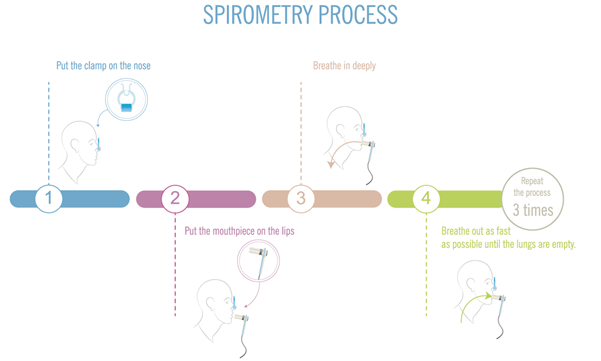What is Spirometry?
Spirometry, also known as a Lung Function test, is a diagnostic and preventive tool used to assess lung function by measuring the volume and flow of air that an individual inhales and exhales. This non-invasive pulmonary lung function test plays a crucial role in evaluating respiratory health and detecting potential lung disease early on.
What Does Spirometry Measure?
In simple terms, spirometry measures:
- The volume of air a subject can blow out after a maximum inhalation.
- The speed of air the subject can blast during exhalation.
During a spirometry test, individuals are instructed to take a deep breath and exhale forcefully into a machine called a spirometer.
Reasons to Perform Spirometry
- Possible exposure to a known respiratory irritant.
- Exposure to a substance that is known/ suspected to cause an occupational lung disease.
- Requirement by employer.
- To assess fitness for a specific task or meet a standard.
Spirometry Measurements
During a lung function test, various spirometry measurements are recorded, including:
FEV1 (Forced Expiratory Volume in 1 second): This is the maximum amount of air you can breathe out in just one second.
FVC/VC (Forced Vital Capacity): The greatest volume of air your lungs can expel after taking the deepest possible breath.
FEV1/FVC Ratio: This ratio helps determine the proportion of FEV1 to FVC and is useful in diagnosing obstructive and restrictive lung diseases.
PEF (Peak Expiratory Flow): The maximum airflow when exhaling steadily.
Forced Expiratory Flow (or Mid-Expiratory Flow): How fast air comes out of the lungs during the middle of a forced breath out.
IVC (Inspiratory Vital Capacity): The maximum amount of air you can inhale after a full exhale.
These spirometry measurements provide valuable insights into lung capacity, airflow limitations, and the presence of conditions such as chronic obstructive pulmonary disease (COPD) or asthma.
How to Perform Spirometry Testing

Spirometry Technician Training
Spirometry is an active test, requiring participants to put in their maximum effort. Therefore, it is essential for technicians to know how to guide and coach participants to ensure they give their best during the test, ensuring accurate results. Therefore, for the participant to perform an acceptable spirometry test, the technician needs to be trained.
In the United States, there are convenient training programs for occupational health professionals to learn spirometry. These programs teach essential skills like using spirometers, interpreting spirometry test results, and following guidelines. You can find a list of spirometry NIOSH-approved courses here.
Spirometry is a powerful tool in respiratory health assessment, offering benefits ranging from early disease detection to occupational safety and fitness evaluation. Understanding the importance of spirometry empowers individuals and healthcare professionals alike to prioritize lung health and take proactive measures toward a healthier future.
To learn more about spirometry including how to choose the correct spirometer and spirometer calibration read: Getting Started with Spirometry
Download our spirometer comparison chart here
In need of spirometry supplies? Visit Mye3Shop
For more information on spirometry, reach out to your nearby e3 Diagnostics expert today.
Contact Us
Follow us on Social!


If you haven't already, make sure to subscribe to our newsletter to keep up-to-date with our latest resources and product information.